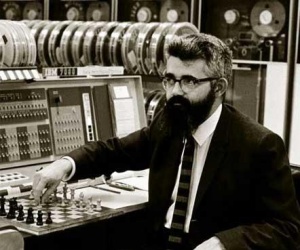Kotok-McCarthy-Program
Home * Engines * Kotok-McCarthy-Program
The Kotok-McCarthy-Program,
also known as "A Chess Playing Program for the IBM 7090 Computer" was the first computer program to play chess convincingly. Between 1959 and 1962, while student of John McCarthy at the Massachusetts Institute of Technology, Alan Kotok and his fellows Elwyn Berlekamp, Michael A. Lieberman, Charles Niessen and Robert A. Wagner wrote a chess program for the IBM 7090. Based on Alex Bernstein's 1957 program and routines by McCarthy and Paul W. Abrahams, they added alpha-beta pruning to minmax, at McCarthy's suggestion. The Kotok-McCarthy-Program was written in Fortran and FAP, the IBM 7090 macro assembler.
Contents
Type B
Kotok-McCarthy was a selective Shannon Type B kind of program. It considered only a few plausible moves as function of increasing ply
{4, 3, 2, 2, 1, 1, 1, 1, 0, 0}
and therefor had some tactical flaws. Quote by Richard Greenblatt concerning Mac Hack VI from his Oral History [3]:
Most of this printout was analysis from the Kotok program. And I also saw some kind of a textual thing, which I don’t believe was Kotok’s thesis, but which had some of the same information as Kotok’s thesis. It was probably some kind of a technical report, or something, that was anticipatory to Kotok’s thesis [4]. Anyway, one of the things I remembered, and which I just talked with Kotok, as a matter of fact, a few days ago, was the detail that they had is Alpha Beta, and so forth, and they had these whips, and the whips were set at 4, 4, 3, 3, 2, 2, 1, 1. In other words, that was how many. It would first look at the top ply. It would look at the four best moves. The next plys, it would look at the three best. Next ply, two best, next ply, one best. Well, I just recognized immediately that that was incredibly wrong.
You see, basically looking at only one wide, you just have no signals or noise function. In other words, you look at one move, which you think is the best, but there’s a tremendous amount of noise. Well, you look at some more moves, and if you find that one of those are better, you’ve effectively rejected some noise. Well, essentially the thing that I knew that they did, they were very weak chess players, both McCarthy and Kotok. And basically they had a very romanticized view of chess. And so I knew, however, that chess is a very, very precise game. And you really- the name of the game is take the other guy’s pieces, and you don’t just go along. In any kind of a strong game, you don’t just lose pieces, win pieces, lose pieces, win pieces. I mean, if you lose even a single pawn without compensation, then you may have drawing chances, if you’re lucky. Otherwise, the game is lost. Losing more than one pawn almost invariably results in loss of the game, period.
Stanford-ITEP Match
see main article Stanford-ITEP Match
After graduated from MIT, Kotok lost interest in computer chess but his program remained alive. When McCarthy left MIT to take charge of the Artificial Intelligence Laboratory at Stanford, he took Kotok's program with him and improved it's searching. At the end of 1966 a four game match began between the Kotok-McCarthy program, running on a IBM 7090 computer, and a program developed at the Institute of Theoretical and Experimental Physics (ITEP) in Moscow which used a Soviet M-20 computer. The match played over nine months was won 3-1 by the The ITEP program, despite playing on slower hardware.
Quotes
Quote from Alan Kotok's Oral History concering the development of a chess program under John McCarthy at MIT:
So there were a total of five people. There was the initial four were, besides me, Charles Niessen, Chuck Niessen, whose these days is some sort of director over at Lincoln Lab. And Mike Lieberman, who is on the faculty at Berkeley. And Elwyn Berlekamp, who is also Berkeley faculty, and fairly famous computer game theory person. Elwyn dropped out of this project at some point, and Bob Wagner, another so these were all sort of East Campus Model Railroad Club friends - and Bob Wagner is at, I think, University of North Carolina - what’s in Raleigh-Durham?
See also
- The Bernstein Chess Program
- History of Computer Chess
- Stanford-ITEP Match
- Type B Search in Mac Hack VI
Publications
- Alan Kotok (1962). Artificial Intelligence Project - MIT Computation Center: Memo 41 - A Chess Playing Program. pdf
- Alan Kotok (1962). A Chess Playing Program for the IBM 7090. B.S. Thesis, MIT, AI Project Memo 41, Computation Center, Cambridge MA. pdf
- Michael Brudno (2000). Competitions, Controversies, and Computer Chess, pdf
External Links
- Kotok-McCarthy-Program from Wikipedia
- Classic Computer Chess - ... The programs of yesteryear by Carey, hosted by the Internet Archive [5]
- Opening Moves: Origins of Computer Chess from The Computer History Museum
References
- ↑ John McCarthy, artificial intelligence pioneer, playing chess at Stanford's IBM 7090 | Mastering the Game | The Computer History Museum 1967 ca., Courtesy Stanford University, John McCarthy used an improved version of the Kotok program to play correspondence chess against a Soviet program developed at the Moscow Institute of Theoretical and Experimental Physics (ITEP) by George Adelson-Velsky and others. In 1967, a four-game match played over nine months was won 3-1 by the Soviet program.
- ↑ CSD founding faculty from Computer History Exhibits Photo Tour created January 2000 by Gio Wiederhold
- ↑ Oral History of Richard Greenblatt (pdf) from The Computer History Museum
- ↑ Alan Kotok (1962). Artificial Intelligence Project - MIT Computation Center: Memo 41 - A Chess Playing Program. pdf
- ↑ Re: Old programs CHAOS and USC by Dann Corbit, CCC, July 11, 2015
